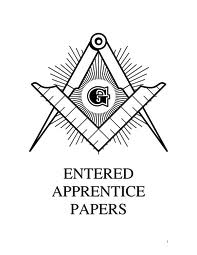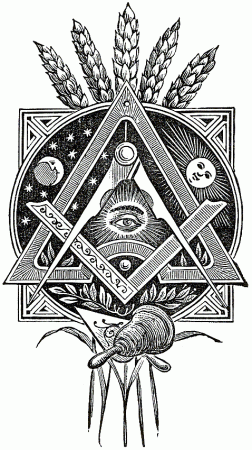The Inventors
By: R.W.Bro. Brad Fickling, DDGM London East District, Grand Lodge of Canada in the Province of Ontario And a member of Nilestown. No 345
The theme that I have selected for my Masonic talks on my official visits is “Masons were there – a historical timeline of Operative and Speculative Masons”. In previous talks, I have already examined an overview of famous masons throughout history, explored the role of operative masons building King Solomon’s Temple, joined the Knight’s Templar during the crusades in the Holy Land, examined the exquisite architecture of Rosslyn Chapel in Scotland, and assessed the role of the great Cathedral Builders on modern Freemasonry. I have also addressed how an impressive list of speculative Mason’s contributed to the founding of both the United States of America and our own country of Canada. I have recognized how our heroic brethren in World War I and World War 2 fought for human dignity, political freedom and democracy. In my last official visit we appreciated our Masonic brethren who have achieved what many others would have deemed impossible, men who traveled to places beyond our imaginations, the “Explorers”.
Tonight we focus on “The Inventors”, those men who used their intellect and imaginations for the betterment of mankind, men who truly were researching into the hidden mysteries of nature and science in their own fields of study.
In the late 1700’s, Benjamin Franklin’s inventions revealed his natural curiosity about how things work and how to make them better. Ben Franklin was a member of St. John’s Lodge in Philadelphia PA. He had poor vision and needed glasses to read. He got tired of constantly taking them off and putting them back on, so he decided to figure out a way to make his glasses let him see both near and far. He had two pairs of spectacles cut in half and put half of each lens in a single frame, thereby inventing the bifocal.
When his brother suffered from kidney stones, he developed a flexible urinary catheter to make him feel better, the first one produced in America. On his eight voyages across the Atlantic Ocean, Ben had time to learn about ships and how they worked. His idea of watertight compartments in the ships hold prevented many ships from sinking and saved many lives at sea.
Everyone knows the story of Ben’s famous kite flight. Although he did not invent electricity, he did invent the lightning rod which protected buildings and ships from lightning damage. In colonial America, most people warmed their homes by building a fire in the fireplace even though it was dangerous and used a lot of wood. Ben figured a better way by inventing an iron furnace we know call a Franklin stove. He also invented the first fire company and the first fire insurance company to help people live more safely. As postmaster, he invented a simple odometer to keep track of distances on his routes.
 In the 1840’s, Edward Jenner, a member of Faith and Friendship Lodge # 270 in Berkeley U.K., gave the world his vaccination for smallpox. This disease was greatly feared at the time as it killed one in three of those who caught it and badly disfigured those who were lucky enough to survive it. Jenner was a country doctor who had studied nature and his natural surroundings since childhood. He had been fascinated by a rural old wives tale that milkmaids could not get smallpox, but only a weak version of it. He observed that milkmaids developed blisters on their hands when they got smallpox and the puss in those blisters somehow protected them. By injecting this puss into a healthy young boy and then injecting him with smallpox, he made his brilliant discovery for the vaccination of smallpox. Jenner did not patent his discovery as it would have made the vaccination more expensive and out of the reach of many. It was his gift to the world. In London England in 1844, 8,048 people died of smallpox in that year. In 1980, the World Health Organization declared smallpox was extinct throughout the world, thanks to Edward Jenner.
In the 1840’s, Edward Jenner, a member of Faith and Friendship Lodge # 270 in Berkeley U.K., gave the world his vaccination for smallpox. This disease was greatly feared at the time as it killed one in three of those who caught it and badly disfigured those who were lucky enough to survive it. Jenner was a country doctor who had studied nature and his natural surroundings since childhood. He had been fascinated by a rural old wives tale that milkmaids could not get smallpox, but only a weak version of it. He observed that milkmaids developed blisters on their hands when they got smallpox and the puss in those blisters somehow protected them. By injecting this puss into a healthy young boy and then injecting him with smallpox, he made his brilliant discovery for the vaccination of smallpox. Jenner did not patent his discovery as it would have made the vaccination more expensive and out of the reach of many. It was his gift to the world. In London England in 1844, 8,048 people died of smallpox in that year. In 1980, the World Health Organization declared smallpox was extinct throughout the world, thanks to Edward Jenner.
In 1907, the Nobel Prize in Physics was awarded to Albert A. Michelson, a member of Washington Lodge # 21 in New York City. His invention of an interferometer was able to measure the velocity of light and able to demonstrate that light travels at a constant speed. His work helped establish the use of range finders used by the Navy in wartime.
 In the same year of 1907, Canadian John McLaughlin of Cedar Lodge # 270 G.R.C., invented the modern Canada Dry version of ginger ale. His mass bottling technique created a very successful sales campaign of that well known label of a map of Canada and a picture of a beaver.
In the same year of 1907, Canadian John McLaughlin of Cedar Lodge # 270 G.R.C., invented the modern Canada Dry version of ginger ale. His mass bottling technique created a very successful sales campaign of that well known label of a map of Canada and a picture of a beaver.
 In 1928, Scottish biologist Sir Alexander Fleming, made a discovery that would change the course of history. The active ingredient in a mould he named penicillin, turned out to be an infection fighting agent of enormous potency. The most important life saving drug in the world, penicillin would alter forever the treatment of bacterial infections. By the middle of the century, Fleming’s discovery had spawned a huge pharmaceutical industry, churning out synthetic penicillins that would conquer some of mankind’s most ancient scourges, including syphilis, gangrene and tuberculosis. Sir Alexander Fleming held Grand Office in the United Grand Lodge in England.
In 1928, Scottish biologist Sir Alexander Fleming, made a discovery that would change the course of history. The active ingredient in a mould he named penicillin, turned out to be an infection fighting agent of enormous potency. The most important life saving drug in the world, penicillin would alter forever the treatment of bacterial infections. By the middle of the century, Fleming’s discovery had spawned a huge pharmaceutical industry, churning out synthetic penicillins that would conquer some of mankind’s most ancient scourges, including syphilis, gangrene and tuberculosis. Sir Alexander Fleming held Grand Office in the United Grand Lodge in England.
Throughout the 1920’s, 30’s and 40’s, Vannevar Bush was an active mason with the Richard C. Maclaurin Lodge for members of the Massachusetts Institute of Technology. He was an American engineer and science administrator known for his work on analog computing, his role in the Manhattan Project developed the nuclear bomb and introduced the idea of memex, a memory bank that preceded development of the world wide web. Bush was a well known policy maker and public intellectual during WWII where he became the first presidential science adviser. He coordinated the activities of six thousand leading scientists in the application of science to warfare.
 In the 1970’s, an American computer engineer and programmer Steve Wozniak founded Apple Computers with the late Steve Jobs and Ronald Wayne. Wozniak helped create the Apple I and Apple II computers that contributed greatly to the microcomputer revolution of that era. Steve Wozniak is a member of Charity Lodge #362 in Campbell CA. His latest claims to fame though are appearing on Dancing with the Stars and playing himself in an episode of the hit television series Big Bang Theory.
In the 1970’s, an American computer engineer and programmer Steve Wozniak founded Apple Computers with the late Steve Jobs and Ronald Wayne. Wozniak helped create the Apple I and Apple II computers that contributed greatly to the microcomputer revolution of that era. Steve Wozniak is a member of Charity Lodge #362 in Campbell CA. His latest claims to fame though are appearing on Dancing with the Stars and playing himself in an episode of the hit television series Big Bang Theory.
In conclusion, these are but a few of a long list of masons who have made significant contributions to their communities, their countries and to the world. These were men who used their intellectual powers to become useful members of society, and like skillful craftsmen, strived to excel in what is good and great.











I am very proud of them.